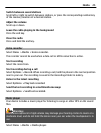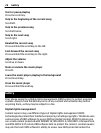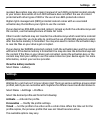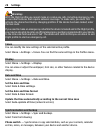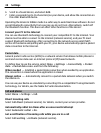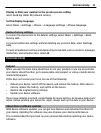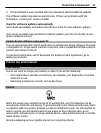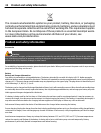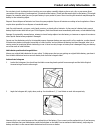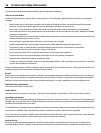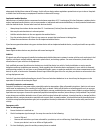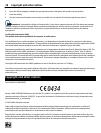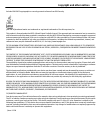
adequately shielded from external RF energy. Switch off your device when regulations posted instruct you to do so. Hospitals
or health care facilities may use equipment sensitive to external RF energy.
Implanted medical devices
Manufacturers of medical devices recommend a minimum separation of 15.3 centimetres (6 inches) between a wireless device
and an implanted medical device, such as a pacemaker or implanted cardioverter defibrillator, to avoid potential interference
with the medical device. Persons who have such devices should:
• Always keep the wireless device more than 15.3 centimetres (6 inches) from the medical device.
• Not carry the wireless device in a breast pocket.
• Hold the wireless device to the ear opposite the medical device.
• Turn the wireless device off if there is any reason to suspect that interference is taking place.
• Follow the manufacturer directions for the implanted medical device.
If you have any questions about using your wireless device with an implanted medical device, consult your health care provider.
Hearing aids
Some digital wireless devices may interfere with some hearing aids.
Vehicles
RF signals may affect improperly installed or inadequately shielded electronic systems in motor vehicles such as electronic fuel
injection, electronic antilock braking, electronic speed control, and air bag systems. For more information, check with the
manufacturer of your vehicle or its equipment.
Only qualified personnel should service the device or install the device in a vehicle. Faulty installation or service may be
dangerous and may invalidate your warranty. Check regularly that all wireless device equipment in your vehicle is mounted
and operating properly. Do not store or carry flammable liquids, gases, or explosive materials in the same compartment as the
device, its parts, or accessories. Remember that air bags inflate with great force. Do not place your device or accessories in the
air bag deployment area.
Switch off your device before boarding an aircraft. The use of wireless teledevices in an aircraft may be dangerous to the
operation of the aircraft and may be illegal.
Potentially explosive environments
Switch off your device in any area with a potentially explosive atmosphere. Obey all posted instructions. Sparks in such areas
could cause an explosion or fire resulting in bodily injury or death. Switch off the device at refuelling points such as near gas
pumps at service stations. Observe restrictions in fuel depots, storage, and distribution areas; chemical plants; or where blasting
operations are in progress. Areas with a potentially explosive atmosphere are often, but not always, clearly marked. They include
areas where you would be advised to turn off your vehicle engine, below deck on boats, chemical transfer or storage facilities
and where the air contains chemicals or particles such as grain, dust, or metal powders. You should check with the manufacturers
of vehicles using liquefied petroleum gas (such as propane or butane) to determine if this device can be safely used in their
vicinity.
Emergency calls
Make an emergency call
1 Ensure the device is switched on.
2 Check for adequate signal strength. You may also need to do the following:
• Insert a SIM card.
• Remove call restrictions you have activated for your device, such as call barring, fixed dialling, or closed user group.
• Ensure your device is not in an offline or flight profile.
3 To clear the display, press the end key as many times as needed.
Product and safety information 37




